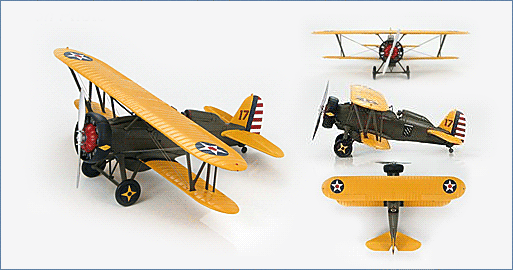Air Power Series>1:48 die-cast display model>F4B>HA7902
P-12E US ARMY 16th Pursuit Group, Canal Zone 1934

General Background
In the early 1930s Boeing developed a series of biplanes designated the F4B for the US Navy and US Marine Corps but was a P-12 for the US Army Air Corps. The aircraft were first accepted in 1929 and served as the primary fighter. The P-12 was built in 6 successful variants while the F4B had 4. The P-12 was replaced by the Boeing P-26 in 1934-35 but the F4B carried on with operational duties until the Grumman F2F/F3F series completely replaced them in 1938.
The Aircraft
Considering the use of aircraft during WWI the U.S. military became worried about the
vulnerability of the Panama Canal. Using the canal reduced the time needed to move USN
ships from coast to coast by weeks. In 1928 the U.S. Congress authorized funds to build a new
airfield to protect the canal. Actual work began in 1930 and the new Albrook Field was
commissioned in April, 1932. The 16th Pursuit Group, comprised of the 24th, 29th, 74th, and
79th Pursuit Squadrons, was stationed there.
Specifications :
| Total Produced All Variants: | 586 |
| First Flight: | June 25, 1928 |
| Role: | Fighter Biplane |
| Powerplant: | 1 x Pratt & Whitney R-1340-16 WASP air-cooled 9 cylinder radial engine, 550 hp (410 kW) |
| Performance: | |
| Speed: | 189 mph (164 kts / 304 km/h) |
| Service Ceiling: | 26,900 ft (8,199 m) |
| Range: | 369 mi (321 nm / 594 km) |
| Weight: | |
| Empty: | 2,355 lb (1,068 kg) |
| Max Takeoff: | 3,611 lb (1,638 kg) |
| Dimensions: | |
| Length: | 20.08 ft (6.12 m) |
| Height: | 9.32 ft (2.84 m) |
| Wingspan: | 29.99 ft (9.14 m) |

